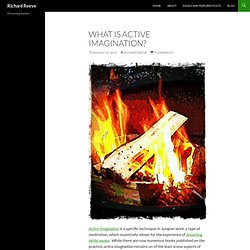

Wp-content/uploads/2012/06/EmbodiedActiveImaginationebook-2.pdf. Carl Jung. Carl Gustav Jung (/jʊŋ/; German: [ˈkarl ˈɡʊstaf jʊŋ]; 26 July 1875 – 6 June 1961), often referred to as C.

G. Jung, was a Swiss psychiatrist and psychotherapist who founded analytical psychology.[2] Jung proposed and developed the concepts of the collective unconscious, archetypes, and extraversion and introversion. What is Active Imagination? Active Imagination is a specific technique in Jungian work, a type of meditation, which essentially allows for the experience of dreaming while awake.

While there are now numerous books published on the practice, active imagination remains on of the least know aspects of Jung’s enterprise, though The Red Book was developed mainly through the technique. In fact, much of what today is considered Jungian theory was first formulated for Jung in his experiences of active imagination. To experience active imagination you need to lower your threshold of consciousness to place which resembles the first waking moments each day. This type of consciousness is known as the hypnogogic. Jung found it useful to focus on moods which were irritating him.
Soul-Making Halfway in Between. Processing the Archetypal. Working with individuals and their analytic processes is a tremendous privilege.

At times the archetype of process leads them through the darkest valleys. Then, there can be stretches of staleness, discouragement and frustration. Yet at other times things seem to fall together in a momentous fashion, with transformative repercussions effecting not only their lives but the environments through which they move. Always amazing in the work, regardless of the phase (the phases of the archetype of process can be distilled into union – death – rebirth), is how the archetypal energies guide the process.